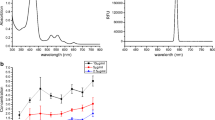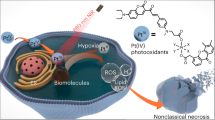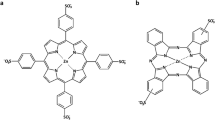Abstract
Objectives
To investigate the biocompatibility of human gastric carcinoma cells (SGC-7901) with organic two-photon nanoparticles (NPs).
Results
Different concentrations of NPs were incubated with SGC-7901 cells for different times. The levels of cell apoptosis, reactive oxygen species (ROS), intracellular calcium, and mitochondrial membrane potential (MMP) were measured by staining the SGC-7901 cells with Annexin V-FITC/PI, 2′,7′-dichlorofluorescin diacetate, Fluo-3 AM, and Rhodamine 123, followed by the flow cytometry assay. NPs at <4 µg/ml, did not have any significant effect on apoptosis, necrosis, generation of ROS, increase of intracellular Ca2+ concentration or decrease of MMP in SGC-7901 cells, but >4 µg/ml had a major effects on all the above mentioned parameters.
Conclusion
2,5,2′,5′-Tetra(4-N,N-diphenylamine styryl) biphenyl NPs can be used at an appropriate concentration as a safe drug carrier or imaging marker and may serve as an effective tool for developing a photodynamic cancer therapy.




Similar content being viewed by others
References
Albanese A, Tang PS, Chan WC (2012) The effect of nanoparticle size, shape, and surface chemistry on biological systems. Annu Rev Biomed Eng 14:1–16
Brookes PS, Yoon Y, Robotham JL, Anders MW, Sheu SS (2004) Calcium, ATP, and ROS: a mitochondrial love-hate triangle. Am J Physiol Cell Physiol 287:C817–C833
Chakraborti T, Das S, Mondal M, Roychoudhury S, Chakraborti S (1999) Oxidant, mitochondria and calcium: an overview. Cell Signal 11:77–85
Gonzalez-Flores D, Espino J, Bejarano I, Lopez JJ, Rodriguez AB, Pariente JA (2010) Caspase-3 and -9 are activated in human myeloid HL-60 cells by calcium signal. Mol Cell Biochem 333:151–157
Gonzalez-Flores D, De Nicola M, Bruni E, Caputo F, Rodriguez AB, Pariente JA, Ghibelli L (2014) Nanoceria protects from alterations in oxidative metabolism and calcium overloads induced by TNFalpha and cycloheximide in U937 cells: pharmacological potential of nanoparticles. Mol Cell Biochem 397:245–253
Halestrap AP, Doran E, Gillespie JP, O’Toole A (2000) Mitochondria and cell death. Biochem Soc Trans 28:170–177
He L, Poblenz AT, Medrano CJ, Fox DA (2000) Lead and calcium produce rod photoreceptor cell apoptosis by opening the mitochondrial permeability transition pore. J Biol Chem 275:12175–12184
He F, Tian LL, Tian XY, Xu H, Wang YH, Xie WJ, Hanif M, Xia JL, Shen FZ, Yang B (2007) Diphenylamine-substituted cruciform oligo(phenylene vinylene): enhanced one-and two-photon excited fluorescence in the solid state. Adv Funct Mater 17:1551–1557
Lemasters JJ (1999) V. Necrapoptosis and the mitochondrial permeability transition: shared pathways to necrosis and apoptosis. Am J Physiol 276:G1–G6
Lewinski N, Colvin V, Drezek R (2008) Cytotoxicity of nanoparticles. Small 4:26–49
Marchetti P, Decaudin D, Macho A, Zamzami N, Hirsch T, Susin SA, Kroemer G (1997) Redox regulation of apoptosis: impact of thiol oxidation status on mitochondrial function. Eur J Immunol 27:289–296
Nel A, Xia T, Madler L, Li N (2006) Toxic potential of materials at the nanolevel. Science 311:622–627
Orrenius S, Zhivotovsky B, Nicotera P (2003) Regulation of cell death: the calcium-apoptosis link. Nat Rev Mol Cell Biol 4:552–565
Perrone GG, Tan SX, Dawes IW (2008) Reactive oxygen species and yeast apoptosis. Biochim Biophys Acta 1783:1354–1368
Xiao-Dong L, Shu-Min Y, Hong X, Yu-Guang M (2012) Evaluation of the cytotoxicity about photic organic nanoparticles. Chem J Chin Univ 33:210–214 (in Chinese)
Xu H, Yang S-M, Chen G, Tian L-L, He F, Wang G-Y, Ma Y-G (2010) Organic two-photon fluorescence nanoparticles for cell stains. Chem J Chin Univ 4:003
Yang S, Lu D, Tian L, He F, Chen G, Shen F, Xu H, Ma Y (2011) Stable water-dispersed organic nanoparticles: preparation, optical properties, and cell imaging application. Nanoscale 3:2261–2267
Acknowledgments
This study was financially supported by the National Science Foundation of China (No. 51173066).
Author information
Authors and Affiliations
Corresponding authors
Ethics declarations
Conflicts of interest
There is no conflict of interest involved in the study.
Rights and permissions
About this article
Cite this article
Chen, G., Li, SY., Malik, H.T. et al. Organic two-photon nanoparticles modulate reactive oxygen species, intracellular calcium concentration, and mitochondrial membrane potential during apoptosis of human gastric carcinoma SGC-7901 cells. Biotechnol Lett 38, 1269–1276 (2016). https://doi.org/10.1007/s10529-016-2105-4
Received:
Accepted:
Published:
Issue Date:
DOI: https://doi.org/10.1007/s10529-016-2105-4




